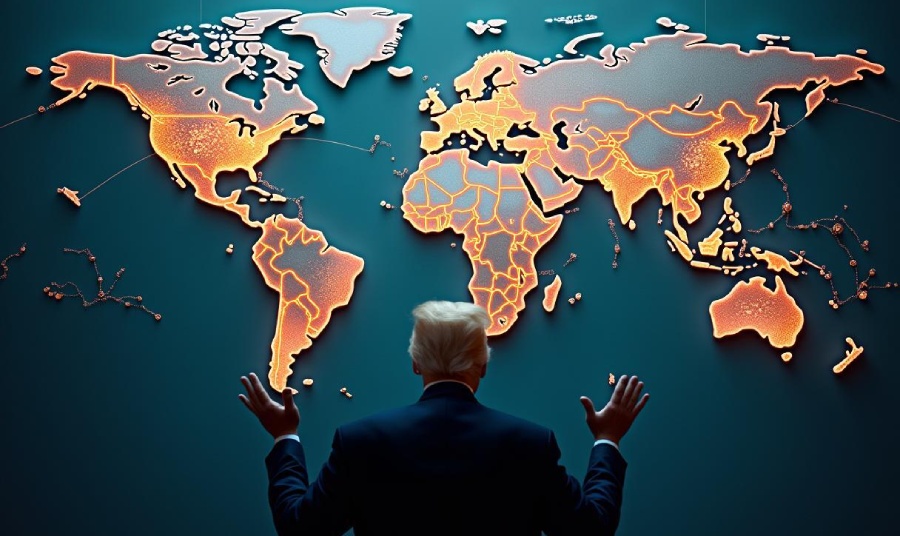Trump’s new pharma tariffs demand action. Learn the strategic imperative to leverage CDMO services and expand your pharma contract manufacturing network for API sourcing and global resilience.
The global pharmaceutical industry, a complex ecosystem built on international supply chains and cross-border collaboration, is bracing for a profound shift. With the re-introduction of protectionist trade policies, pharmaceutical companies worldwide face an urgent mandate: transform their operating model or absorb significant financial and operational damage.
Upon taking office, President Donald Trump moved swiftly to implement a new trade agenda, encapsulated by the America First Trade Policy and the Fair and Reciprocal Trade Plan. These policies are not theoretical concepts; they represent concrete threats to the established global norms of pharmaceutical sourcing and manufacturing. This article outlines the imminent challenges posed by these tariffs, explores the resulting supply chain vulnerabilities, and, crucially, details the strategic imperative for pharmaceutical companies to mitigate this risk through a proactive and expanded network of contract development and manufacturing organization (CDMO) partners and diversified global production.
The New Trade Landscape: Tariffs and the Threat to Pharma
Since January 20, the Trump administration has signaled a clear intent to overhaul the U.S. trade relationship with the world. The America First Trade Policy launched an investigation into “Unfair and Unbalanced Trade,” targeting countries with significant trade deficits with the U.S. This probe includes major pharmaceutical hubs across the European Union (such as Germany, Ireland, and Italy) and Asia (including Vietnam, Japan, and Taiwan). The ultimate goal is to subject these partners to new, country-specific tariffs.
The subsequent Fair and Reciprocal Plan, introduced in February, escalated the challenge. It aims to evaluate and impose reciprocal tariffs on countries that enforce higher duties or non-tariff barriers on U.S. goods. Potential targets include the European Union, India, and Japan-all critical nodes in the global drug supply chain.
The most direct threat to the sector, however, came with the announcement of a plan to impose 25% tariffs on imported pharmaceuticals, alongside semiconductors and automobiles. With the investigations expected to conclude by April 1, new tariffs could take effect as soon as April 2, leaving the industry little time to react. The implication is a forceful push to increase drug production within the United States, fundamentally altering the economics of pharmaceutical trade.
Dual Impact: The Financial Strain on U.S. and Global Pharma
The potential imposition of these tariffs creates a seismic shockwave with distinct, yet interconnected, impacts on both U.S. purchasers and global pharma contract manufacturing companies.
The U.S. Domestic Impact: Price Hikes and Margin Erosion
For U.S. importers and purchasers, the financial implications are staggering. The existing tariff measures, which currently cost the Pharmaceutical, Life Science, and Medical Device industry around $0.5 billion a year, could explode to nearly $63 billion a year based on one analysis. Furthermore, the specialized 25% tariff on imported pharmaceuticals could generate an additional $76 billion in tariff revenue.
This cost will not simply vanish. It will lead to:
- Higher Drug Prices for U.S. Consumers: Tariffs are, in essence, a tax on imports. Companies will be forced to pass at least a portion of this dramatically increased cost onto consumers, exacerbating the already contentious issue of drug affordability in the U.S.
- Margin Erosion: Companies unable to fully transfer the tariff cost will see their profit margins severely compressed, threatening R&D investment and overall shareholder returns.
- Complex Compliance Costs: Navigating evolving tariff rates, assessing the pre- and post-impact on earnings per share (EPS), and modeling complex supply chain changes require significant administrative overhead and strategic review.
The Global Impact: Disruption and Strategic Uncertainty
For active pharmaceutical ingredient manufacturers and finished dose producers outside the U.S., the tariffs threaten to de-link their products from the world’s most lucrative market. Countries accustomed to predominantly duty-free or low duty rates will face sudden economic barriers. This creates deep strategic uncertainty, forcing foreign companies to re-evaluate their entire business model, from customs valuation strategies (e.g., first sale for export) to the declared country of origin, which becomes a complex and high-stakes endeavor under conflicting World Trade Organization rules.
The Supply Chain Vulnerability: A Bigger Problem
While the financial metrics are alarming, the most critical long-term consequence of the tariffs lies in the exposure of existing supply chain fragility. The pharmaceutical industry is heavily reliant on foreign countries for both API suppliers (Active Pharmaceutical Ingredients) and raw materials.
Historically, this reliance was built on a drive for efficiency and cost minimization, resulting in a geographically consolidated and highly specialized global supply chain. Tariffs, however, instantly weaponize this consolidation. A 25% levy on pharmaceuticals from a major sourcing nation can instantaneously sever or severely cripple a major supply route.
This disruption is not just about cost; it is about resilience and national security. The tariffs highlight that an over-reliance on a few foreign jurisdictions for essential medicines and their components is a strategic weakness. The consequence of a supply chain breach-whether due to trade wars, geopolitical events, or even natural disasters-is not a delay in consumer goods, but a shortage of life-saving drugs. The potential for immediate adverse impacts is high, demanding a radical overhaul of current operational strategies.
Strategic Mitigation: Diversification Through Network Expansion
To counteract the unpredictable and corrosive effects of the new tariff regime, the only sustainable defense for the pharmaceutical industry is proactive, strategic diversification and network expansion. This strategy must focus on two symbiotic pillars: geographically expanding production footprints and establishing resilient, multi-source partnerships.
Pillar 1: Expand Production and Decentralize Manufacturing
The industry must shift its focus from least-cost sourcing to most-resilient sourcing. This means actively mitigating concentration risk by expanding production capacity outside of potential tariff hotspots, including and beyond the U.S.
- U.S. Manufacturing Ramping: While politically appealing and tariff-proof for U.S. sales, expanding domestic manufacturing must be weighed against high labor and compliance costs. It is a necessary component but not the sole solution.
- Strategic Nearshoring/Friendshoring: Companies should pivot production to jurisdictions that are either politically aligned with the U.S. or that offer advantageous trade agreements and a stable supply of raw materials. This includes leveraging existing agreements like the USMCA review for North American production or exploring expansion in established pharmaceutical manufacturing centers not targeted by the tariffs.
- Dual-Sourcing Mandates: Every key intermediate, raw material, and API should be mandated for production in a minimum of two separate, non-adjacent geographic regions. This redundancy ensures that if one trade route is blocked by tariffs or other crises, the other remains viable.
Pillar 2: The Power of Strategic Partnerships – Focusing on CDMOs
The expansion of production is an expensive and time-consuming endeavor. The most agile and capital-efficient route to diversification is through leveraging the global network of contract development and manufacturing organization (CDMO) partners. This is where the strategy of mitigation meets the economic reality of operational change.
CDMO services offer the immediate capacity, specialized expertise, and geographic flexibility needed to rapidly de-risk a pharmaceutical supply chain. Companies should prioritize:
- Selecting Global CDMOs with Multi-Site Capabilities: The ideal partner is a contract development and manufacturing organization with a footprint spanning multiple continents, allowing a pharmaceutical company to shift production rapidly without changing partners. If tariffs are imposed on goods from Facility A in Country X, the CDMO can immediately pivot production to Facility B in Country Y, which may be tariff-exempt or subject to different trade rules.
- Engaging Specialized API Manufacturers: Given the 25% tariff target on pharmaceuticals, securing the raw material pipeline is paramount. Strategic engagement with diversified API manufacturers is non-negotiable. These active pharmaceutical ingredient manufacturers are the foundation of drug production. Working with a network of API suppliers across a range of geographies-from established markets to emerging, tariff-advantaged locations-provides the necessary shield against trade volatility.
- Utilizing a Pharma Sourcing Platform: The task of identifying, vetting, and managing this expanded network of pharmaceutical contract manufacturing partners is immense. This is where modern digital infrastructure comes into play. Leveraging a pharma sourcing platform like Pharmalinkage.com allows pharmaceutical companies to quickly match their capacity needs with available, geographically diverse CDMO services and pharma contract manufacturing companies that can satisfy both regulatory requirements and new trade constraints. A robust sourcing platform cuts down the lead time for establishing new manufacturing relationships from months to weeks, a crucial advantage when facing imminent tariff deadlines.
In essence, the solution is to treat pharmaceutical contract manufacturing as a strategic risk management tool rather than merely a cost center. By investing in resilient partnerships with pharma contract manufacturing companies, the industry moves from a vulnerable, linear supply chain to a secure, decentralized network.
Conclusion: Turning Trade Barriers into Competitive Advantage
The potential imposition of 25% tariffs on imported pharmaceuticals by the Trump administration is a profound challenge, threatening to raise costs for U.S. consumers and destabilize the global supply chain. The industry could face a financial headwind potentially reaching tens of billions of dollars.
However, a strategic threat can be converted into a competitive advantage. The imperative is clear: the most resilient pharmaceutical companies of the future will be those that move decisively now to de-risk their production network.
This is not a time for incremental adjustments. It is the moment for transformative network expansion. By prioritizing partnerships with global, multi-site contract development and manufacturing organization (CDMO) partners, diversifying the source base of API manufacturers and API suppliers, and utilizing an efficient pharma sourcing platform to rapidly forge new alliances, companies can build a supply chain that is inherently immune to geopolitical shocks.
In the face of the tariff tide, the strategy is simple: expand, diversify, and partner. Those who successfully leverage CDMO services and the broader pharmaceutical contract manufacturing ecosystem to build a globally decentralized network will not only mitigate the tariff challenge but also emerge stronger, more resilient, and better positioned to secure the world’s access to life-saving medicines.
Pharma Contract Manufacturing Strategy
Pharma Contract Manufacturing Strategy
Comments are closed.












